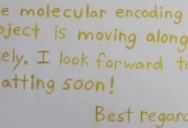You May Be Able to Send Secret Messages in the Molecular Code of Ink Someday
Do you remember those invisible ink sets you used to be able to buy out of magazines and comic books back in the day?
They’d (sort of) work for a day or two and then that would be the end of it. It was a novelty for kids.
But thanks to scientists at the University of Texas, sending secret messages in the molecular code of ink might be something that we’ll all be doing sooner than later.

Photo Credit: Amazon
A new study from the Texas researchers focuses on an example of steganography that is an encrypted message-within-a-message. Professor Eric Anslyn is a big fan of The Wizard of Oz and he encrypted the book by L. Frank Baum and sent it to a colleague.
And for this experiment, it was all about the ink. Anslyn explained that his team used a special kind of polymer and encoded a 256-character key to encrypt and decrypt the book.
The study says, “To store 256 bits of information, we chose to encode a cipher key in hexadecimal (base-16) in a mixture of eight 10-mer [oligourethanes]. Eight of the 10 monomers encode information … In base-16, each monomer provides a storage density of 4 bits per monomer, thus 32 bits per 10-mer, and overall, 256 bits in the sample.”
The team then mixed these oligourethanes with soot, isopropanol, and glycerol, and they had an ink they could use for their project.

Photo Credit: Dahlhauser et al., ACS Central Science 2022
Anslyn said, “The most important scientific breakthrough was the use of mass tags that allow us to sequence eight oligourethanes simultaneously. This is the real advance in the field. The encryption key was just a single application that can be envisioned.”
Pretty exciting stuff, don’t you think?

Sign up to get our BEST stories of the week straight to your inbox.




